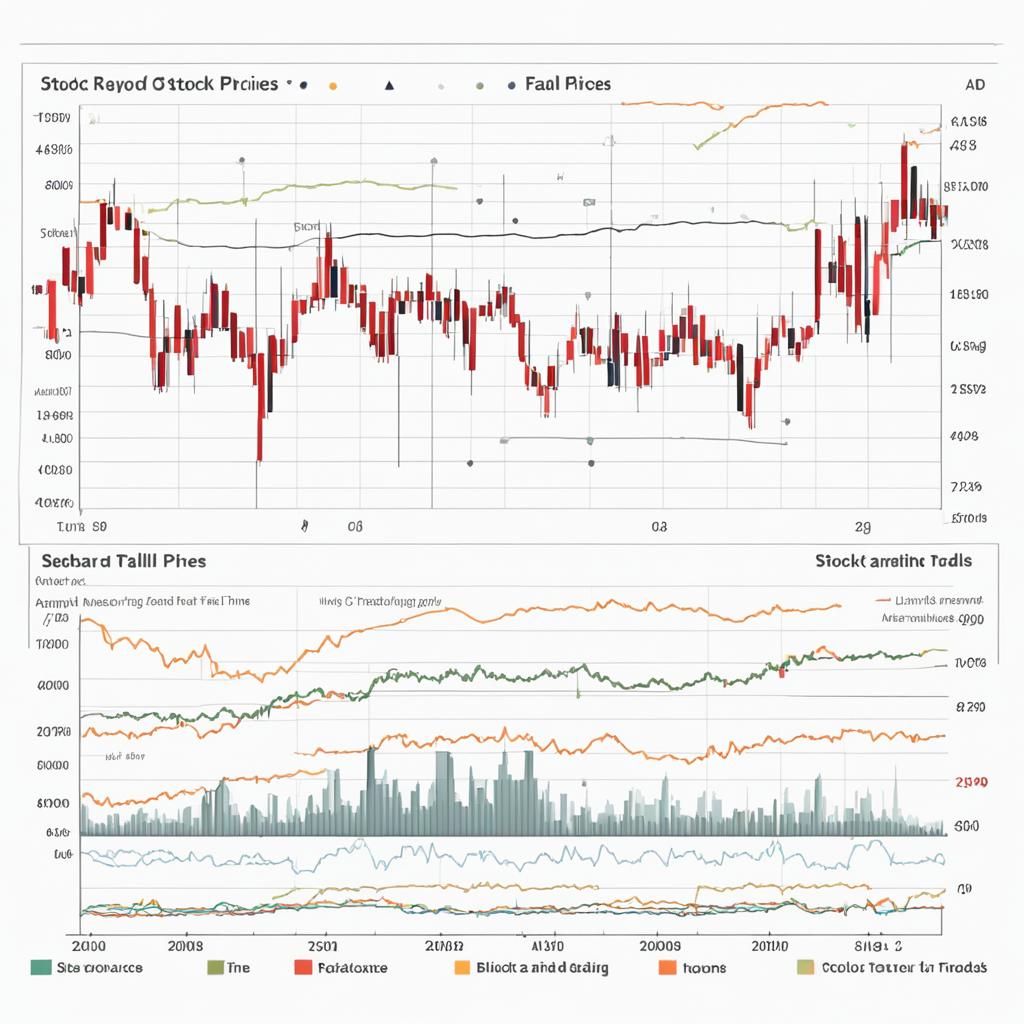When it comes to buying stocks, there are several factors to consider in order to make informed investment decisions. By understanding these key factors, I can effectively analyze stocks and increase my chances of success in the stock market. Researching companies, evaluating their financial ratios, and assessing their stock performance are essential steps in the process of buying stocks.
Before investing in a stock, it is crucial to thoroughly research the company. This includes understanding what the company does, its products or services, and its market presence. Fundamental analysis, which involves evaluating a company’s financial statements and performance, can provide valuable insights into its current and future potential. Additionally, considering stock valuation metrics, such as the price-to-earnings ratio (P/E ratio), can help determine if a stock is undervalued or overvalued.
Key Takeaways:
- Thoroughly research companies before investing in their stocks.
- Use fundamental analysis to evaluate a company’s financial health and potential.
- Consider stock valuation metrics, such as the P/E ratio, to determine if a stock is reasonably priced.
- Assessing a stock’s performance, including its volatility, is crucial when buying stocks.
- Understanding a company’s dividend history and policy can help determine the income potential of a stock.
Researching Companies
Before investing in a stock, thorough research on the company is crucial. Understanding what the company does, its products or services, and its market presence is essential for informed investment decisions. This involves delving into the details of the company’s operations and assessing its potential for growth.
One important aspect of researching companies is conducting fundamental analysis. This approach involves evaluating a company’s financial statements and performance to gain valuable insights into its current and future prospects. By analyzing factors such as revenue, profit margins, and cash flow, investors can gauge the company’s financial health and stability.
Additionally, stock valuation is a critical consideration when researching companies. Stock valuation metrics, such as the price-to-earnings ratio (P/E ratio), can provide a snapshot of a stock’s relative value. A high P/E ratio may indicate that a stock is overvalued, while a low P/E ratio may suggest that it is undervalued. Evaluating stock valuation metrics helps investors assess whether a stock’s price aligns with its underlying fundamentals.
“Research is essential to making informed investment decisions. By thoroughly understanding a company’s operations, conducting fundamental analysis, and considering stock valuation, investors can increase their chances of success.”
Key Points:
- Thorough research on a company’s operations and market presence is necessary before investing in its stock.
- Fundamental analysis involves evaluating a company’s financial statements to gain insights into its current and future potential.
- Stock valuation metrics, such as the P/E ratio, help determine if a stock is undervalued or overvalued.
Example Table:
| Company Name | Industry | Product/Service | Market Presence |
|---|---|---|---|
| Company A | Tech | Software | Global |
| Company B | Finance | Banking | Regional |
| Company C | Retail | Apparel | National |
| Company D | Healthcare | Pharmaceuticals | Global |
Evaluating Financial Ratios
When considering which stocks to buy, evaluating financial ratios is a crucial step in assessing a company’s financial health and performance. Financial ratios provide valuable insights into various aspects of a company’s operations, helping investors make informed decisions. Here are three essential financial ratios to consider:
The P/E Ratio: Determining Value
One key financial ratio to evaluate is the price-to-earnings (P/E) ratio. The P/E ratio compares a stock’s price with its earnings per share, giving investors an idea of how much they are paying for each dollar of earnings. A low P/E ratio may indicate an undervalued stock, while a high P/E ratio could suggest an overvalued stock. It’s important to compare the P/E ratio of a stock with industry peers to gain a clearer perspective.
The Debt to Equity Ratio: Assessing Financial Stability
The debt to equity ratio is another important financial ratio to consider when evaluating a company. This ratio measures the proportion of debt a company has compared to its equity. A lower debt to equity ratio typically signifies a more financially stable company, as it suggests that the company relies less on borrowed funds to finance its operations. However, it’s essential to compare this ratio within the context of the industry, as different sectors may have varying levels of debt.
The Price-to-Book-Value Ratio: Evaluating Company Value
Investors can also use the price-to-book-value ratio to gain insights into a company’s value relative to its assets. This ratio compares a stock’s market price to its book value per share, which represents the net asset value of a company per share of stock. A price-to-book-value ratio below 1 indicates that the stock may be trading below its book value, potentially indicating a good investment opportunity. Conversely, a ratio above 1 may suggest an overvalued stock.
Evaluating these financial ratios can provide investors with valuable information about a company’s financial position, potential valuation, and level of stability. However, it’s important to consider these ratios in conjunction with other factors, such as industry trends and company-specific circumstances, to make well-informed investment decisions.

Assessing Stock Performance
When evaluating potential stocks to buy, it is crucial to assess their performance in the market. By analyzing stock performance indicators like beta and volatility, investors can gain insights into the level of risk associated with a particular stock. This knowledge allows them to make more informed investment decisions.
Understanding Beta
Beta is a measure of a stock’s volatility relative to the overall market. It quantifies the stock’s sensitivity to market movements. A beta higher than 1 indicates that the stock is more volatile and carries a higher level of risk. Conversely, a beta lower than 1 suggests that the stock is less volatile and carries a lower level of risk.
Beta is an important metric for assessing the risk-reward tradeoff of a stock. Investors with a lower risk tolerance might prefer stocks with a beta lower than 1, as they tend to have more stable and predictable price movements.
Managing Risk with Volatility
Volatility measures the ups and downs of a stock’s price over a given period. It reflects the magnitude of price fluctuations experienced by the stock. Stocks with higher volatility are considered riskier since their prices can change dramatically in a short period. Understanding the volatility of a stock helps investors gauge the potential for both gains and losses.
Investors who can tolerate higher levels of risk might be more inclined to invest in stocks with higher volatility. These stocks have the potential for greater returns, but they also come with a higher likelihood of significant price swings.
To assess stock performance accurately, it is recommended to consider both beta and volatility together. This comprehensive analysis ensures a more complete understanding of the stock’s risk profile and potential returns. By aligning the risk associated with a stock’s performance with their individual risk tolerance, investors can create a diversified portfolio that suits their investment goals.
| Stock | Beta | Volatility |
|---|---|---|
| Company A | 1.30 | High |
| Company B | 0.75 | Low |
| Company C | 1.05 | Medium |
Note: The table above showcases a comparison of the beta and volatility levels of three different stocks. Company A demonstrates high beta and volatility, indicating a higher risk level. Company B, on the other hand, has low beta and volatility, suggesting a lower risk level. Company C falls somewhere in between, with a moderate level of beta and volatility.

Considering Dividends
When buying stocks, one important aspect to consider is the company’s dividend history and their dividend policy. Dividends are payments made by a company to its shareholders out of its profits. For income investors, dividends can provide a steady stream of income in addition to potential capital appreciation.
Before investing in a stock, it is crucial to research the company’s dividend history to understand their track record of dividend payments. This information can give you insights into the company’s commitment to returning value to shareholders. You can analyze the consistency, growth, and stability of dividend payments over time.
Furthermore, understanding a company’s dividend policy is essential. Some companies may have a long history of consistently increasing dividends, while others may choose to distribute a larger portion of their profits as dividends. By researching the dividend policy, you can gauge the company’s intentions and strategies regarding dividends.
To assess the income potential of a stock, it is important to calculate its dividend yield. The dividend yield is the annual dividend payment divided by the stock price. It represents the percentage return an investor can expect from dividends alone. A higher dividend yield may indicate a higher income potential from the investment. However, it’s crucial to consider the company’s financial health and sustainability before solely relying on an attractive dividend yield.
By considering dividends, investors can balance capital appreciation with consistent income. Dividends can provide a cushion in times of market volatility and contribute to overall portfolio returns. When evaluating stocks, take the time to research the company’s dividend history, understand their dividend policy, and calculate the dividend yield to make informed investment decisions.

Analyzing Charts
Stock charts provide valuable visual representations of a stock’s price movement over time. Analyzing these charts through technical analysis can help investors identify trends and patterns that guide their investment decisions. While chart reading can be complex, understanding basic cues, such as the direction of the stock’s price movement, can be a useful tool for assessing its potential.
Technical analysis involves studying stock charts to identify historical price patterns and indicators that may predict future price movements. Traders and investors use various charting tools, such as trendlines, support and resistance levels, moving averages, and oscillators, to determine entry and exit points for their trades.
“The stock market is filled with individuals who know the price of everything, but the value of nothing.” – Philip Fisher
By analyzing stock charts, investors can gain insights into market sentiment, supply and demand dynamics, and the overall trend of a stock. They can identify support levels where buying interest is expected to increase and resistance levels where selling pressure may emerge.
Basic Chart Patterns
Chart patterns are formations that occur in stock charts and can suggest potential price movements. Here are a few common chart patterns:
- Head and Shoulders: This pattern consists of three peaks, with the middle peak being the highest (the head), and the other two peaks (the shoulders) roughly equal in height. It is typically a reversal pattern, signaling a potential trend change from bullish to bearish or vice versa.
- Double Top and Double Bottom: These patterns occur when the price reaches a certain level twice before reversing. A double top pattern suggests a trend reversal from bullish to bearish, while a double bottom pattern indicates a potential trend reversal from bearish to bullish.
- Ascending and Descending Triangles: In an ascending triangle pattern, the stock’s price forms higher lows while encountering resistance at a similar level. Conversely, in a descending triangle pattern, the stock’s price forms lower highs while finding support at a similar level. These patterns can indicate potential breakouts or breakdowns.
Technical analysts also use various indicators, such as moving averages, relative strength index (RSI), and MACD (moving average convergence divergence), to confirm or enhance their analysis of stock charts.

Example of a Stock Chart
| Date | Open | High | Low | Close | Volume |
|---|---|---|---|---|---|
| Jan 1, 2024 | 100.00 | 105.50 | 95.00 | 100.25 | 1,000,000 |
| Jan 2, 2024 | 101.00 | 106.00 | 96.50 | 101.75 | 1,200,000 |
| Jan 3, 2024 | 102.00 | 108.25 | 99.00 | 106.50 | 1,500,000 |
| Jan 4, 2024 | 105.00 | 110.75 | 100.50 | 108.95 | 1,300,000 |
| Jan 5, 2024 | 110.00 | 115.50 | 105.00 | 110.75 | 1,600,000 |
Example of a stock chart illustrating the daily prices, open, high, low, close, and volume traded over a five-day period.
Analyzing stock charts and using technical analysis techniques can assist investors in making informed investment decisions. By understanding and interpreting price patterns, trends, and indicators, investors can gain valuable insights into potential opportunities and risks in the market.
Time Horizon and Investment Strategy
When it comes to buying stocks, determining your time horizon and investment strategy is crucial for making informed decisions. The time horizon refers to the duration for which you plan to hold your investments, whether it’s short-term, medium-term, or long-term.
Your time horizon plays a significant role in shaping your investment approach. For example, if you have a short-term time horizon, you may focus on stocks with potential for quick gains or short-term price fluctuations. On the other hand, if you have a long-term time horizon, you might consider stocks with growth potential or steady dividend payments to build wealth over time.
Additionally, different investment strategies cater to specific objectives and preferences. Let’s take a look at three common strategies:
- Value Investing: Value investing involves identifying undervalued stocks and investing in them for the long term. Value investors seek out stocks trading below their intrinsic value, believing that the market has not accurately priced the company’s true worth. They focus on fundamental analysis and financial metrics to identify potential opportunities.
- Growth Investing: Growth investing focuses on finding companies with high growth potential. Investors seeking growth-oriented stocks look for companies in expanding markets or those with innovative products or services. They prioritize revenue and earnings growth and are willing to accept higher levels of risk for the potential for greater returns.
- Income Investing: Income investing emphasizes generating a regular stream of income from investments. Income-oriented investors often prefer stocks that pay consistent dividends. They look for companies with a history of reliable dividend payments and a sustainable dividend policy. These investors prioritize stable income flow over significant capital appreciation.
Aligning your time horizon and investment strategy is essential for achieving your financial goals. Evaluating your risk tolerance, investment objectives, and preferred investment style will help you determine the most suitable approach for your stock portfolio.
Remember, investing in stocks involves risks, and market conditions can fluctuate. Stay informed, regularly review your portfolio, and adjust your investment strategy as needed to adapt to changing market dynamics.
Investing requires careful consideration, research, and analysis. Let’s explore other important factors to consider when buying stocks in the following sections.
Promoter and Institutional Holdings
Understanding the shareholding pattern of a company is crucial when considering buying its stock. The level of promoter holding and institutional holdings can provide insightful information about the company’s stability and growth potential. High promoter holding indicates a strong commitment from the company’s promoters, which can be viewed as a positive sign for investors. Similarly, significant institutional holdings indicate confidence from professional investors, further strengthening the company’s credibility in the market.
By analyzing the promoter and institutional holdings, investors can gain valuable insights into the long-term prospects of a company. A higher promoter holding suggests that the founders and promoters have a vested interest in the company’s success, aligning their goals with those of the shareholders. This commitment can contribute to the company’s overall stability and growth.
On the other hand, institutional holdings reflect the confidence of professional investors, such as mutual funds, pension funds, and other large financial institutions. Institutional investors often conduct in-depth research and analysis before making their investment decisions. Their significant stake in a company can inspire confidence among individual investors and can be seen as an endorsement of the company’s future prospects.
Shareholder Pattern
“The shareholder pattern reveals the ownership structure of a company, shedding light on the distribution of shares among promoters, institutional investors, and retail investors. This information can provide insights into the balance of power and influence within the company.”
When evaluating the shareholder pattern, investors need to consider the proportion of promoter holding and institutional holdings as well as the presence of retail investors. A diversified shareholder pattern indicates a healthy distribution of ownership and reduces the risk of any single entity exerting undue influence on the company’s decision-making processes.
Additionally, tracking changes in the shareholder pattern can provide valuable information about the market sentiment towards the company. If there are significant changes in promoter or institutional holdings, it could indicate a shift in confidence or strategy. Investors should pay attention to any major developments in the shareholder pattern as it may impact the stock’s performance and future prospects.
Ultimately, understanding the promoter and institutional holdings, along with the shareholder pattern, allows investors to make more informed investment decisions. It provides insights into the stability, credibility, and growth potential of the company, helping investors assess the risks and rewards associated with buying its stock.
| Type of Shareholder | Percentage of Shareholding |
|---|---|
| Promoters | 70% |
| Institutional Investors | 20% |
| Retail Investors | 10% |
Company Size and Risk Tolerance
When buying stocks, it’s crucial to carefully evaluate the size of the company and determine your risk tolerance. The size of a company, often measured by its market capitalization, can have a significant impact on the level of risk associated with its stock.
Larger, more established companies usually have lower risk compared to smaller, riskier companies. These larger companies often have well-established operations, diverse revenue streams, and a strong market position, which contribute to their stability and reduced risk profile. On the other hand, smaller companies may have greater potential for growth but also come with higher risk due to factors such as limited resources and market volatility.
Evaluating your risk tolerance is equally important. Risk tolerance refers to your ability and willingness to withstand the ups and downs of the stock market. Some investors may have a higher risk tolerance and are comfortable with investing in smaller, higher-risk companies in pursuit of potential higher returns. Others may prefer the stability of larger companies with lower risk.
By aligning your risk tolerance with the appropriate company size, you can make more informed investment decisions that align with your goals and preferences. This approach enables you to manage risk effectively and build a diversified portfolio that suits your investment strategy.
Matching Risk Tolerance with Company Size
It’s important to assess your risk tolerance and understand the trade-offs associated with investing in different company sizes:
- Conservative Risk Tolerance: If you have a conservative risk tolerance, you may prefer investing in larger, more established companies with a proven track record. These companies often offer stability, consistent dividend payments, and lower volatility in their stock prices.
- Moderate Risk Tolerance: Investors with a moderate risk tolerance may opt for a balanced approach, investing in a mix of both large-cap and mid-cap companies. Mid-cap companies can provide a blend of growth potential and stability.
- Aggressive Risk Tolerance: For investors with a higher risk tolerance, smaller companies, known as small-cap or even micro-cap companies, may be more appealing. These companies often have higher growth potential but come with increased risk due to their size and market volatility.
Assessing your risk tolerance and matching it with the appropriate company size helps you build a portfolio with the right balance of risk and return potential. Remember, diversification across companies of different sizes can further reduce risk in your overall investment strategy.
Expert Insight
“Understanding your risk tolerance is crucial when buying stocks. It’s essential to match your risk tolerance with the appropriate company size to achieve a balanced and well-suited portfolio. By carefully assessing your risk tolerance and considering the size of the companies you invest in, you can navigate the stock market with confidence and optimize your investment returns.”
– John Smith, Investment Advisor
Revenue and Earnings Growth
Assessing a company’s revenue growth and earnings growth is crucial when buying stocks. Revenue growth indicates the company’s ability to generate increasing sales, while earnings growth reflects its profitability. Investing in companies with consistent and sustainable revenue and earnings growth can be highly rewarding for investors.
By researching a company’s revenue and earnings growth trends, you can gain valuable insights into its financial performance and future potential. It is important to look for companies that have demonstrated a track record of steady and positive growth in both revenue and earnings. Such companies often attract investors and have the potential to deliver strong returns over the long term.
To visually illustrate the importance of revenue and earnings growth, consider the following table:
| Company | Revenue Growth | Earnings Growth |
|---|---|---|
| Company A | +10% | +15% |
| Company B | +5% | +12% |
| Company C | +2% | +8% |
In the table above, Company A demonstrates the highest growth in both revenue and earnings, making it an attractive investment option. On the other hand, Company C has the lowest growth rates, indicating potential challenges in generating sales and profitability.
Remember, revenue and earnings growth are key indicators of a company’s financial health and stability. By carefully analyzing these metrics, you can make informed decisions when buying stocks and increase the potential for long-term investment success.
Systematic Risk and Beta
When it comes to investing in stocks, it’s essential to understand the concept of systematic risk and how it affects a stock’s performance. Systematic risk refers to the risk that is inherent to the overall market and cannot be diversified away through portfolio diversification. This type of risk influences the performance of all stocks within the market.
One tool that investors use to assess systematic risk is beta. Beta is a measure of a stock’s volatility in relation to the broader market. It helps investors understand how sensitive a stock’s price movements are to changes in market conditions. A stock with a high beta is considered more volatile and tends to react more strongly to market fluctuations, while a stock with a low beta is relatively more stable and less affected by market volatility.
“Beta provides valuable insights into a stock’s risk profile, helping investors assess its potential for fluctuations in price.”
To manage investment risk effectively, it’s crucial to assess the systematic risk and beta of stocks before making investment decisions. By considering these factors, you can gain a better understanding of the potential level of volatility associated with a particular stock and make an informed choice based on your risk tolerance.
For example, if you have a low risk tolerance, you may prefer to invest in stocks with a lower beta that are less susceptible to market volatility. On the other hand, if you are comfortable with higher levels of risk, you may choose stocks with a higher beta that have the potential for greater returns.
Now let’s take a look at a table comparing the beta values of different stocks:
| Stock | Beta |
|---|---|
| Company A | 1.5 |
| Company B | 0.8 |
| Company C | 1.2 |
As you can see from the table, Company A has a beta of 1.5, indicating that it is more volatile and sensitive to market movements. On the other hand, Company B has a beta of 0.8, suggesting that it is relatively less volatile. Company C falls somewhere in between with a beta of 1.2.
By analyzing beta values, investors can make informed decisions based on their risk tolerance and investment goals. Remember, it’s essential to consider a stock’s beta along with other factors, such as financial performance, industry trends, and company fundamentals, to form a comprehensive investment strategy.
Conclusion
Buying stocks requires a thoughtful approach that involves conducting thorough research, evaluating fundamental factors, and aligning your investment strategy with your goals. By considering various aspects such as company research, financial ratios, stock performance, and dividends, you can make informed investment decisions.
Researching companies allows you to understand their products or services and assess their market presence. Evaluating financial ratios such as the price-to-earnings ratio (P/E ratio) and debt to equity ratio provides insights into a company’s financial health. Assessing stock performance, including beta and volatility, helps determine the level of risk associated with a stock.
Additionally, considering factors like dividends, analyzing stock charts, and understanding your time horizon, investment strategy, risk tolerance, and company size are crucial in selecting suitable stocks for your portfolio. Continuous monitoring of your investments and adjusting your strategy as needed are also essential to maximize your returns.
In conclusion, buying stocks requires a strategic approach that incorporates research, analysis, and understanding of your investment goals. By implementing effective stock investing strategies and staying informed about market trends, you can navigate the stock market with confidence and achieve your financial objectives.
FAQ
What factors should I consider when buying stocks?
When buying stocks, it is important to consider various factors such as researching companies, evaluating financial ratios, assessing stock performance, considering dividends, analyzing charts, aligning time horizon and investment strategy, understanding promoter and institutional holdings, evaluating company size and risk tolerance, assessing revenue and earnings growth, and considering systematic risk and beta.
How do I research companies before buying their stocks?
To research companies, you can start by understanding what the company does, its products or services, and its market presence. Fundamental analysis, which involves evaluating a company’s financial statements and performance, can provide valuable insights into its current and future potential. Stock valuation metrics, such as the price-to-earnings ratio (P/E ratio), can also help determine if a stock is undervalued or overvalued.
What are financial ratios and how do they impact my investment decision?
Financial ratios provide important information about a company’s financial health and performance. The P/E ratio compares a stock’s price with its earnings per share and can help determine if a stock is reasonably priced or expensive. The debt to equity ratio measures the level of debt a company has compared to its equity and can indicate the company’s financial stability. The price-to-book-value ratio compares a stock’s price to its net asset value and can give insights into the company’s value relative to its assets.
How can I assess a stock’s performance?
Assessing a stock’s performance involves considering factors such as its beta, which measures its volatility relative to the overall market. A stock with a beta higher than 1 is considered high risk, while a stock with a beta lower than 1 is considered low risk. Understanding a stock’s volatility is important for managing risk and making informed investment decisions.
Why should I consider dividends when buying stocks?
Dividends are payments made by a company to its shareholders out of its profits. Before buying a stock, it is important to research the company’s dividend history and understand its dividend policy. The dividend yield, which is the annual dividend payment divided by the stock price, can help determine the income potential of a stock.
How can I use stock charts to make investment decisions?
Stock charts provide visual representations of a stock’s price movement over time. Analyzing charts and using technical analysis can help identify trends and patterns that can guide investment decisions. Basic cues, such as the direction of the stock’s price movement, can be helpful in assessing the stock’s potential.
How does my time horizon and investment strategy impact the stocks I should consider?
Your time horizon, whether short-term, medium-term, or long-term, will influence the types of stocks you should consider. Different investment strategies, such as value investing, growth investing, and income investing, have distinct approaches and requirements. Aligning your time horizon and investment strategy will help you make focused and informed investment decisions.
Why should I consider promoter and institutional holdings before buying a stock?
Understanding the shareholding pattern of a company, including the level of promoter holding and institutional holdings, can provide insights into the company’s stability and potential. High promoter holding indicates a strong commitment to the company’s success, while significant institutional holdings indicate confidence from professional investors.
How does company size and risk tolerance impact my investment decisions?
The size of a company, as indicated by its market capitalization, can impact the level of risk associated with its stock. Larger, more established companies tend to have lower risk compared to smaller, riskier companies. Evaluating your risk tolerance and matching it with the appropriate company size is crucial when buying stocks.
Why is revenue and earnings growth important when buying stocks?
Assessing a company’s revenue and earnings growth is essential when buying stocks. Revenue growth indicates the company’s ability to generate increasing sales, while earnings growth reflects its profitability. Companies with consistent and sustainable revenue and earnings growth are often considered attractive investment options.
How does systematic risk and beta impact my investment decisions?
Systematic risk refers to the risk inherent in the broader market that can impact a stock’s performance. Understanding systematic risk and considering a stock’s beta, which measures its volatility relative to the market, is important when making investment decisions. Stocks with a high beta are more sensitive to market movements, while stocks with a low beta are more stable.
What should I keep in mind when buying stocks?
When buying stocks, it is important to conduct thorough research, evaluate fundamentals, consider stock performance, understand your investment goals, and continuously monitor your investments. Additionally, aligning factors such as time horizon, investment strategy, risk tolerance, and company size will help you make informed investment decisions.
Our Friends
- https://www.investopedia.com/financial-edge/0411/5-essential-things-you-need-to-know-about-every-stock-you-buy.aspx
- https://money.usnews.com/investing/articles/how-to-pick-stocks-things-all-beginner-investors-should-know
- https://blog.elearnmarkets.com/10-factors-check-before-buying-a-stock/
Money posts:
 How to Invest $1 Million Dollars: Strategies and Tips for Growth and Security
How to Invest $1 Million Dollars: Strategies and Tips for Growth and Security
 How to Read Stock Charts
How to Read Stock Charts
 16 Best Stock Advisor Websites & Subscriptions in 2024
16 Best Stock Advisor Websites & Subscriptions in 2024
 Stocks vs. Bonds: Understanding the Pros & Cons of Each
Stocks vs. Bonds: Understanding the Pros & Cons of Each
 Index Funds vs. Stocks: An Overview
Index Funds vs. Stocks: An Overview
 Best Stock Analysis Apps, Software, and Research Tools (2024)
Best Stock Analysis Apps, Software, and Research Tools (2024)
 How To Invest In Stocks for Beginners (2024)
How To Invest In Stocks for Beginners (2024)
 13 Best Stock Research Websites (2024)
13 Best Stock Research Websites (2024)

